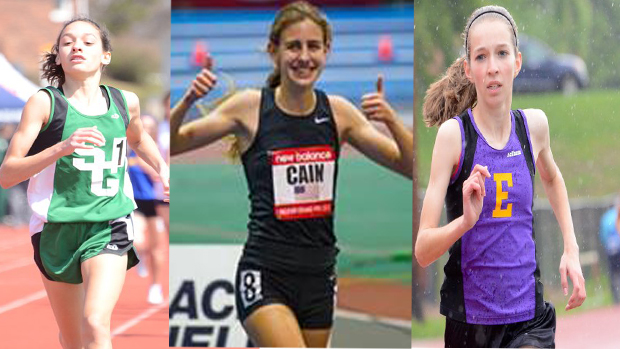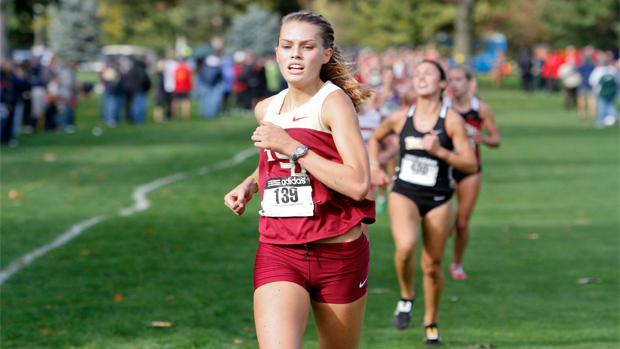
|
Now that spring seems to have finally arrived, training can begin in earnest. Even without the weather cooperating, there have already been some amazing early-season performances. Ste. Genevieve’s Taylor Werner and Eureka’s Hannah Long battled at the Festus Tiger Town Invitational in the 3,200 meter run and turned in Top 10 national times of 10:25.88 and 10:27.49, respectively. Before the season ever started, girls’ track created some buzz when New York junior Mary Cain shattered national records in the mile (4:28.25) and two mile (9:38.68), and she ran a 3k record 9:02.10 on an oversized indoor track, which stands as the new overall mark. Given the recent rise locally of girls’ performances, the question of whether this was just an anomaly or something bigger began to be discussed. A few coaches offered several theories of what might be behind this surge in performances at the elite level. Every year there is a new group of girls doing amazing things on the track. However recently it seems there has been a consistent push by the top-end athletes, who have been breaking records and pushing into new territory. In the 400 meter dash, eight of the fastest 10 times in the state have been run since 2005, including Berkeley’s Alishea Usery’s 2007 record of 53.55. Howell’s Whitney Adams ran a 54.70 last year as a junior and could climb from her current spot of fifth later this year. Ladue’s Samantha Levin crushed a 19-year-old record in 2011 with her 2:06.74 in the 800, and five of the top six times have been run since 2003. The 1,600 and 3,200 records of Megan Thompson have also been under assault recently by the likes of Parkway Central’s Diane Robison and Emily Sisson, Nerinx Hall’s Colleen Quigley, Festus’ Alyssa Allison, Lee’s Summit West’s Liga Blyholder and Chelsea Phoebus, Kickapoo’s Liz Reida and Blue Springs South’s Samantha Nightingale. Thompson’s 1990 record in the 3,200 fell in 2009 when Sisson ran a 10:24.12. In the last seven years, there have been five girls run within five seconds of Thompson’s 1989 record of 4:47.53. So what is behind this surge in performances, especially in the distance races? Nerinx Hall coach Gaylerd Quigley said a lot of credit goes to better training techniques. Quigley said he has been a disciple of the Jack Daniels’ running formula, which provides a numerical rating based on accomplishments. Those ratings are then used to provide target training times broken down into six different intensities depending on the workout. “Programs like this give kids solid and tangible goals to strive for in workouts,” Quigley said. Quigley trained his own daughter, Colleen, who has continued running at an elite level at Florida State, including a recent PR of 9:13.17 in the 3,000 at the ACC indoor championships. He said he kept her mileage low while she was in high school, and he believes that has allowed her to better handle the increased mileage required in college.
“I know Hannah (Long) is a low mileage runner,” Quigley said. “I hope kids like that are not trained to the extreme in high school and fall apart in college.” Quigley said the increased availability of the internet has played a large role as coaches are able to easily trade training ideas, and athletes are better able to stay in touch and compare workouts. The internet also means there is no place to hide with all the results readily available, which means the high school kids cannot slack off because their peers will see those results. Ladue coach Keith Harder agreed that the better attention to training has made a big difference in recent years. He said when he started coaching girls 10 years ago, there was not the depth of quality athletes like now, and that made competing as a team at state for a trophy spot easier. Now, he said it is just as difficult to get a top four spot in the girls standings. “With the guys, there is no room for error (at the state meet),” Harder said. “For the girls, it wasn’t hard because there wasn’t the quality of depth we have now. “When Lee’s Summit West came on the scene, every team in Kansas City got better, and we had to get better over here to keep up.”
Harder said he believes there have always been elite girls running, but that now there is more dedication year-round. He pointed to recent runners Levin and Montenae Roye and their commitment to the sport. “They were track kids, and that’s what they did,” Harder said. “These types of kids have existed in the past, but they were not as committed to track or had the coaching we have now.
“I could’ve made Sam a state champion, but I don’t think I can make Sam a 2:06. (Sean) Burris is cutting edge in training.” So while better training and better coaching seemed to have converged at this point, Lee’s Summit West coach Jesse Griffin said he thinks the expectations have also risen and the athletes are striving to meet the new challenges. “I think it started with (Eureka’s Merideth) Snow, because it had been quite some time since we had a distance runner at that level,” Griffin said. “She broke a psychological barrier, and then Sisson came and said, ‘Yeah, I can run that fast.’ “Kids are going to run fast if the expectation is there.” Griffin said more numbers participating in the sport have also increased the available talent pool of athletes capable of gunning for elite status and state records. Add in the overall physical improvements girls in general have made in the last decade, and Griffin said we should continue to see new and amazing things happen. “I just watched (Brittney) Griner dunk,” Griffin said. “How far has that come?” Since Title IX started to pave the way in 1972, we are now in the third generation of girls competing, and the current field has had parents in sports as role models. Quigley said the genetic pool gets better as parents are athletic and stay fit through the sport, and Harder said the year-round track has also led to lots of parents who met at track meets and now have kids competing, and excelling, in the sport. It is not hard to imagine more state records continuing to fall in the near future. Werner, Long, Adams, Hickman’s Nicole Mello and a whole list too long to print will surely amaze with performances throughout the rest of the season. Milesplit would love to hear your thoughts on why our local girls have been excelling and show no signs of slowing down.
|


